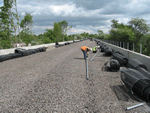 30 November 2009 – By developing a cost-effective, rapid and highly sustainable solution for the Brigg Line embankment in Lincolnshire, Arup and Network Rail, with Tensar International and support services and construction company Carillion, have demonstrated a reinforced soil retaining wall approach using geogrids cast into in-situ reinforced concrete wall facing units that can be used to solve similar challenging problems all over the world.
30 November 2009 – By developing a cost-effective, rapid and highly sustainable solution for the Brigg Line embankment in Lincolnshire, Arup and Network Rail, with Tensar International and support services and construction company Carillion, have demonstrated a reinforced soil retaining wall approach using geogrids cast into in-situ reinforced concrete wall facing units that can be used to solve similar challenging problems all over the world.
“The solution we developed can be applied to road and rail embankments, and across poor ground in many different locations,” says Andy Kirwan, Project Manager for Arup. “The project also has an excellent environmental profile and will save thousands of road transport journeys to the South Humberside Docks.”
The 1.3km twin track stretch of the East Coast Main Line embankment near Brigg needed to be stabilised, as settlement and remedial requirements were causing concern and restricting operational speeds. The pressure to solve the problem was increased as the Network Rail line is an important route for increased rail freight traffic between the North and the South and part of a strategic plan to relieve transport pressure on the road infrastructure.
The 7m high rail embankment traverses a combination of weak silty clay (in the floodplain), peat bog and organic soils, which extend to a depth of between 5 and 15 metres below the surrounding mean ground level; the route includes a bridge across the River New Ancholme.
On such a major rail route, track possession time was critical; in this case 14 weeks was all that was available to excavate, install and reinstate the embankment so that rail traffic could be resumed. In addition, the need for sustainability and working within a tight budget dictated minimum use of imported new materials.
Arup proposed a non-standard reinforced stone solution to Network Rail based on Tensar uniaxial geogrids. Part of the approach was based on the fact that Tensar’s uniaxial geogrids are the only geogrid which have a BBA certificate covering their suitability when cast directly into reinforced concrete. After technical discussions Network Rail took the decision to support this innovative approach and took an active role within delivery of the project.
The proposal given to the contractor (Carillion) was to build the embankment with substantial pre-cast concrete panel walls enclosing a reinforced earth construction. This technique posed the difficulties of taking receipt and storing large quantities of panels and installing and supporting the concrete panels safely whilst significant other activities were ongoing. Carillion identified that this approach had a programme risk due to the installation method and proposed an in-situ construction method. This final solution enabled greater flexibility of construction thus reducing programme risk and speeding the project completion time.
The embankment was excavated down until reasonable ground materials were encountered, and Tensar’s Basetex high strength geotextile was installed as basal reinforcement to provide the required stability.
Then the reinforced concrete walls were cast in low lift heights up to the design level. As limited lateral thrust was imposed on the wall, the embankment could be built up while the concrete wall was curing, saving on project time.
“Around 70% of the ballast fill material was re-used or recycled,” comments Andy Kirwan, Project Manager for Arup. “That was 15,000 tonnes of site-won material largely based on cleaned existing ballast and 53,000 tonnes of recycled imported material. We were also able to reuse fines from the ballast cleaning, and some of the excavated clay, for landscaping the embankment shoulders.”
“Once we had established the construction method with Arup and Carillion, progress was straightforward,” said Craig Andrews Tensar’s Area Civil Engineer. “To help save on-site time when building up the embankment in this way, we were able to precut the uniaxial geogrid to size so that the contractors did not have to measure and cut every roll, it was just laid out on site before laying and compacting the fill.”
The project was completed within the 14 week window and its success, without any overruns, is a tribute to the efficiency of the method. A Network Rail spokesperson has commented favourably on the success of the project which was presented with the award for “Civil Engineering Achievement of the Year” at the 2009 National Rail Awards.
For copies of Tensar International’s Tensartech System brochures, please visit www.tensar.co.uk.
ADDITIONAL LINK
Tensar International profile on Geosynthetica











